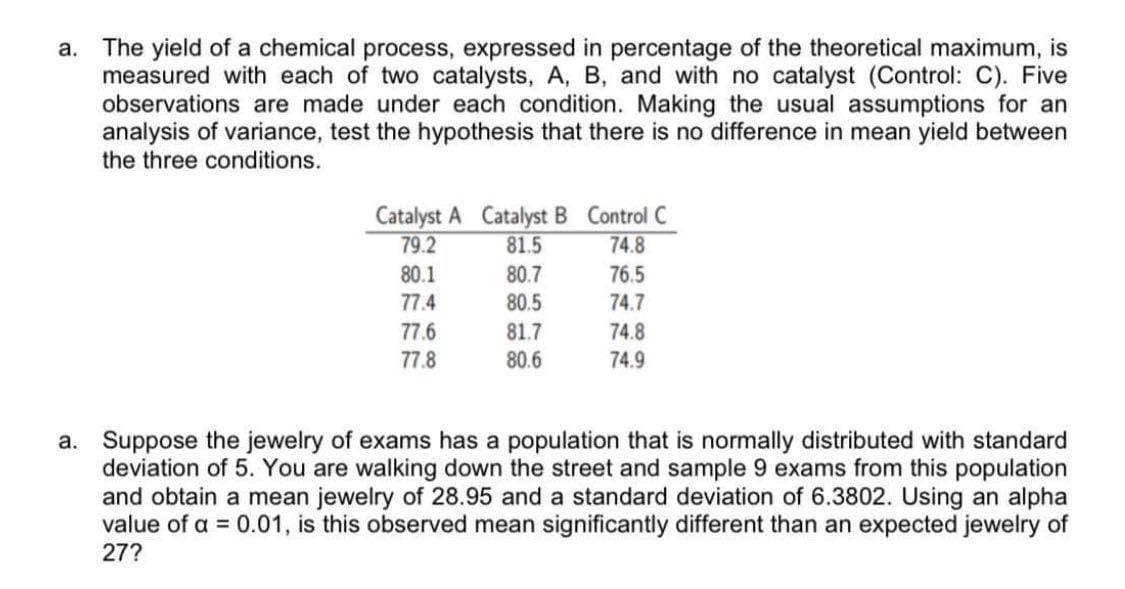The yield of a chemical process, expressed in percentage of the theoretical maximum, is measured with each of two catalysts, A, B, and with no catalyst (Control: C). Five observations are made under each condition. Making the usual assumptions for an analysis of variance, test the hypothesis that there is no difference in mean yield between the three conditions. а. Catalyst A Catalyst B Control C 81.5 79.2 74.8 80.1 80.7 76.5 77.4 80.5 74.7 77.6 81.7 74.8 77.8 80.6 74.9
The yield of a chemical process, expressed in percentage of the theoretical maximum, is measured with each of two catalysts, A, B, and with no catalyst (Control: C). Five observations are made under each condition. Making the usual assumptions for an analysis of variance, test the hypothesis that there is no difference in mean yield between the three conditions. а. Catalyst A Catalyst B Control C 81.5 79.2 74.8 80.1 80.7 76.5 77.4 80.5 74.7 77.6 81.7 74.8 77.8 80.6 74.9
Physical Chemistry
2nd Edition
ISBN:9781133958437
Author:Ball, David W. (david Warren), BAER, Tomas
Publisher:Ball, David W. (david Warren), BAER, Tomas
Chapter22: Surfaces
Section: Chapter Questions
Problem 22.44E: Are the following processes examples of homogeneous or heterogeneous catalysis? a Hydrolysis of...
Related questions
Question
answer a only

Transcribed Image Text:a. The yield of a chemical process, expressed in percentage of the theoretical maximum, is
measured with each of two catalysts, A, B, and with no catalyst (Control: C). Five
observations are made under each condition. Making the usual assumptions for an
analysis of variance, test the hypothesis that there is no difference in mean yield between
the three conditions.
Catalyst A Catalyst B Control C
79.2
81.5
74.8
80.1
80.7
76.5
77.4
80.5
74.7
77.6
81.7
74.8
77.8
80.6
74.9
a. Suppose the jewelry of exams has a population that is normally distributed with standard
deviation of 5. You are walking down the street and sample 9 exams from this population
and obtain a mean jewelry of 28.95 and a standard deviation of 6.3802. Using an alpha
value of a = 0.01, is this observed mean significantly different than an expected jewelry of
27?
Expert Solution
This question has been solved!
Explore an expertly crafted, step-by-step solution for a thorough understanding of key concepts.
This is a popular solution!
Trending now
This is a popular solution!
Step by step
Solved in 2 steps with 4 images

Knowledge Booster
Learn more about
Need a deep-dive on the concept behind this application? Look no further. Learn more about this topic, chemistry and related others by exploring similar questions and additional content below.Recommended textbooks for you

Physical Chemistry
Chemistry
ISBN:
9781133958437
Author:
Ball, David W. (david Warren), BAER, Tomas
Publisher:
Wadsworth Cengage Learning,

Chemical Principles in the Laboratory
Chemistry
ISBN:
9781305264434
Author:
Emil Slowinski, Wayne C. Wolsey, Robert Rossi
Publisher:
Brooks Cole

Chemistry for Engineering Students
Chemistry
ISBN:
9781285199023
Author:
Lawrence S. Brown, Tom Holme
Publisher:
Cengage Learning

Physical Chemistry
Chemistry
ISBN:
9781133958437
Author:
Ball, David W. (david Warren), BAER, Tomas
Publisher:
Wadsworth Cengage Learning,

Chemical Principles in the Laboratory
Chemistry
ISBN:
9781305264434
Author:
Emil Slowinski, Wayne C. Wolsey, Robert Rossi
Publisher:
Brooks Cole

Chemistry for Engineering Students
Chemistry
ISBN:
9781285199023
Author:
Lawrence S. Brown, Tom Holme
Publisher:
Cengage Learning

Principles of Modern Chemistry
Chemistry
ISBN:
9781305079113
Author:
David W. Oxtoby, H. Pat Gillis, Laurie J. Butler
Publisher:
Cengage Learning